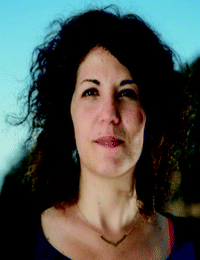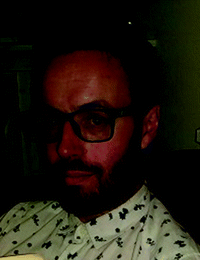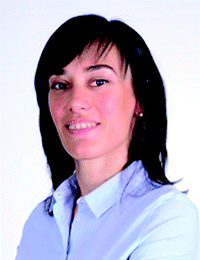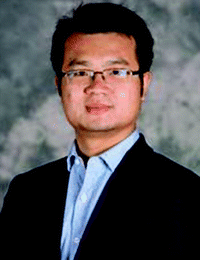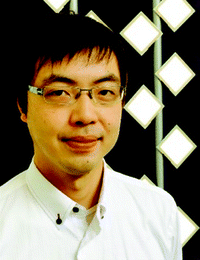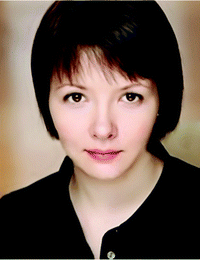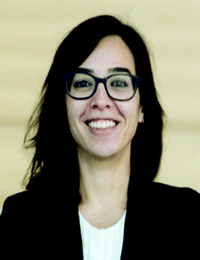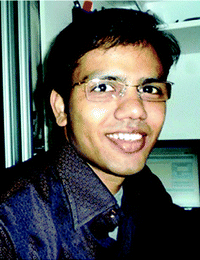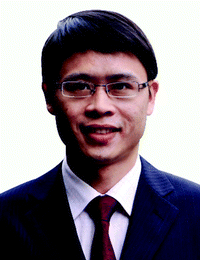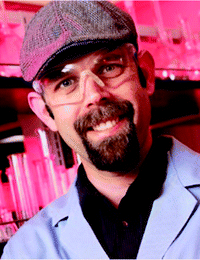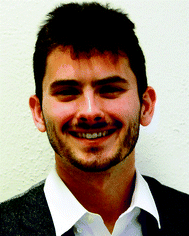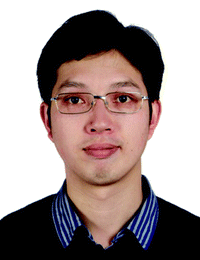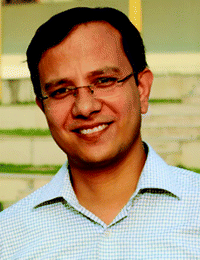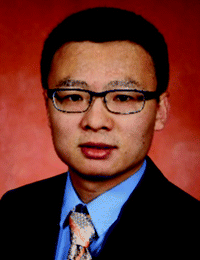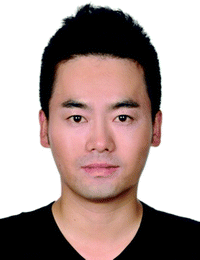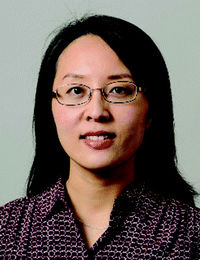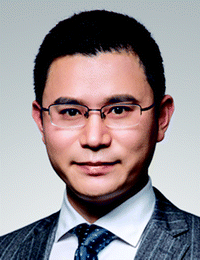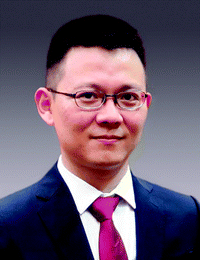Journal of Materials Chemistry C profiles: Contributors to the Emerging Investigators 2018 issue
Abstract
Journal of Materials Chemistry C is proud to present this themed issue highlighting 2018's rising stars of materials chemistry in the areas of optical, magnetic and electronic devices. Our 2018 Emerging Investigators themed issues gather some of the best research being conducted by scientists in the early stages of their independent career. Each contributor was recommended as carrying out work with the potential to influence future directions in materials chemistry. Congratulations to all of the researchers featured, we hope you enjoy reading this issue.
Dr Raffaella Buonsanti is a tenure-track Assistant Professor at the Institute of Chemical Sciences and Engineering (ISIC) of the École Polytechnique Fédérale de Lausanne (EPFL). She received her MSc degree in Chemistry from the University of Bari in 2006. In 2010, she obtained her PhD in Nanochemistry from the University of Salento working at the National Nanotechnology Laboratory (NNL, in Lecce-Italy). After two years as a postdoctoral researcher at the Molecular Foundry at Lawrence Berkeley National Laboratory (2010–2012), she was promoted to Project Scientist, a non-tenure track scientist position, in the same institution. From 2013 to 2015 Raffaella was a tenure-track Staff Scientist in the Department of Materials Science within the Joint Center for Artificial Photosynthesis at LBNL, before moving to EPFL. Here, through her core expertise in colloidal synthesis, she develops novel approaches to complex materials to drive chemical transformations, with particular emphasis on energy-related reactions such as CO2 reduction and water oxidation.
Keith Butler was born in obscurity in the foothills of Dublin, Ireland. At the age of 12 he entered education in a local monastery where he was given an educational grounding in geometry and theology. In early adulthood Keith then entered Trinity College, in the metropolitan heart of Ireland's capital, there he expanded his education and first sparked an interest on the study of converting the phases of matter. After finishing his degree Keith spent some years in obscurity, travelling and writing impenetrable prose and awful poetry. After a Damascene re-conversion, Keith returned to his study of matter, this time exploring exotic porous structures in University College London. After spending time working on the theory of machines for converting sunlight into electricity in Bath and Sheffield, Keith joined the ISIS Neutron and Muon Source at Rutherford Appleton Laboratories. His interest in the structure of materials continues; his research now focuses on the collisions between sub-atomic particles and materials, to gain a deeper understanding of structure and dynamics. He develops thinking automata to assist human interpretation of these processes.
Dr Cristina Cebrián is an Assistant Professor at the University of Lorraine (France). She studied Chemistry at the University of Castilla-La Mancha (Spain), where she also received her PhD in 2011 under the supervision of Prof. A. Díaz-Ortiz and Dr P. Prieto. During her doctoral studies, she made short visits to the groups of Prof. F. P. Cossío (University of the Basque Country, Spain) and Prof. L. De Cola (University of Münster, Germany). After a post-doctoral fellowship in De Cola's group (2012–2013) between the University of Münster and the University of Strasbourg (Institut de Science et d’Ingénierie Supramoléculaires, France), she obtained her current position at the UL in 2013. Her research interests include the synthesis of organic and organometallic materials for optoelectronics and solar energy conversion, with special attention to sustainable synthetic approaches and challenging photoactive systems based on non-toxic and alternative metals.
Dr Zheng Chen is an assistant professor in the Department of NanoEngineering and Materials Science Program at University of California, San Diego. He received his BS from Tianjin University (2007) and PhD from UCLA (2012, with Prof. Yunfeng Lu), both in Chemical Engineering. Then he served as postdoctoral researcher with Prof. Zhenan Bao and Prof. Yi Cui at Stanford University. His research interests lie in the design, synthesis and application of novel functional polymers, nanostructured materials, and their hybrid materials for electronic, energy and environmental applications.
Dr Takayuki Chiba is an assistant professor in the Graduate School of Organic Materials Science at Yamagata University, Japan. He received his PhD in 2011 from the Department of Organic Device Engineering at Yamagata University. He was a post-doctoral fellow at Yamagata University in 2011–2014. His research is focused on perovskite QD-based light-emitting devices.
Dr Simone Fabiano is an Assistant Professor at the Department of Science and Technology at Linköping University. He received his MSc degree in Industrial Chemistry from the University of Catania (2008), and a PhD in Chemistry from the University of Palermo (2012). He then carried out postdoctoral research at Linköping University with Prof. Magnus Berggren, before joining the group of Prof. Antonio Facchetti and Prof. Tobin J. Marks at Northwestern University as a Marie Curie Fellow and a VINNEMER Fellow in 2016. His research interests include organic semiconductors and electrolyte dielectrics for thin-film transistors, as well as conducting polymers for energy harvesting and storage applications.
Dr Marina Freitag is presently Assistant Professor at the Department of Chemistry at Uppsala University, continuing her work in coordination chemistry and solar cells. Previously, she held a post-doctoral position at EPFL (Prof. Anders Hagfeldt's). She received her PhD degree with Prof. Galoppini at Rutgers University, USA, and her BSc in Chemistry at Freie Universität Berlin, Germany. She is the inventor of the so-called Zombie cell and she contributed to recent breakthroughs in dye-sensitized solar cells for low-power applications.
Dr Ori Gidron received his MSc in Chemistry from the Weizmann Institute of Science (2007) under the supervision of Professor M. van der Boom. He then joined the group of Professor M. Bendikov at the Weizmann Institute of Science and received his PhD in 2012, for which he was awarded the Dov-Elad Prize for Excellence in Chemical Research. In June 2013, he started a Marie Curie (IEF) Postdoctoral Fellowship in the group of Professor F. Diederich at ETH Zurich working on supramolecular assemblies of carbon-rich materials. He has been a senior lecturer at the Hebrew University of Jerusalem since 2015. His main interests are chiral organic semiconductors, curved aromatic systems, and furan-containing materials for organic electronics.
Dr Shuzo Hirata received his PhD from Tokyo University of Agriculture and Technology in 2009 under Prof. Toshiyuki Watanabe. In 2009, he joined Prof. Chihaya Adachi's group at Kyushu University as a Postdoctoral Fellow. In 2012, he became an Assistant Professor in the Department of Materials Science at the Tokyo Institute of Technology, working under Prof. Martin Vacha. His independent research career in the Department of Engineering Science at the University of Electro-Communication began in 2018. His group works on the design of photofunctional molecules/materials for photonics and optoelectronics applications with a focus on the intrinsic understanding of how molecular photophysics controls molecular excited states.
Dr Sahika Inal is an Assistant Professor of Bioscience at King Abdullah University of Science and Technology (KAUST). Trained as a textile engineer, she received her MSc in Polymer Science and PhD in Experimental Physics from the University of Potsdam in Germany. Prior to joining KAUST, she was a postdoctoral fellow in the Department of Bioelectronics at the Center of Microelectronics of Provence of EMSE in France. Having made a variety of devices from conjugated polymers in different parts of the world, Sahika is determined to uncover the wonders of these materials at the liquid interface for recording small biological signals and modulating biological events.
Dr Dinesh Kabra is at present an Associate Professor in the Department of Physics at IIT Bombay, Mumbai, India. Before joining IITB, he was a Herchel Smith Research Fellow in the Cavendish Laboratory and also an honorary postdoctoral fellow of Trinity Hall College, University of Cambridge, UK. He received his PhD from JNCASR, Bangalore, India. He has published ∼70 international publications and ∼10 international/national patents in the area of active matrix displays, flexible PV panels and nanogenerators. He is a recipient of an Early Research Achiever Award 2015 and Best Paper Award 2016 of IIT Bombay. His current research interests involve solution processable inorganic and organic semiconductors in order to understand their structure–function relationships via spectroscopy and to transfer that knowledge to the design of high performance optoelectronic devices.
Dr Chenfeng Ke is currently an assistant professor in the Department of Chemistry at Dartmouth College, New Hampshire, United States. He received his BS and PhD degrees from Nankai University, China, in 2004 and 2009, respectively. In 2007–2008, he worked with Professor Yoshihisa Inoue at Osaka University, Japan. He was awarded a Newton International Fellowship in 2009 by the Royal Society (UK) to pursue research with Professor Anthony Davis between 2009 and 2011 at the University of Bristol. He subsequently joined Professor Sir Fraser Stoddart's research group at Northwestern University as a postdoctoral research fellow (2011–2015) before taking up his assistant professorship.
Dr Kathryn E. Knowles earned a BS in Chemistry and a BA in Math from the University of Rochester, NY in 2008. She completed a PhD in chemistry in 2013 as a US Department of Energy Office of Science Graduate Fellow with Emily Weiss at Northwestern University, where she studied the influence of surface ligands on the decay of photogenerated charge carriers in colloidal quantum dots. She conducted postdoctoral research investigating the photophysics of transition metal-doped quantum dots with Daniel Gamelin at the University of Washington with the support of a DOE Energy Efficiency and Renewable Energy Postdoctoral Research Award. In 2016, she returned to her hometown institution, the University of Rochester, as an Assistant Professor of Chemistry. Research in the Knowles group focuses on the synthesis and investigation of the fundamental optical, electronic, and chemical properties of binary and ternary transition metal oxide nanocrystals and thin films, with a focus on materials that have potential applications in solar energy conversion and storage.
Dr Wen-Ya Lee is an assistant Professor of Chemical Engineering and Biotechnology at National Taipei University of Technology (NTUT). He received his PhD degree in Chemical Engineering from National Taiwan University in 2009 and joined Prof. Wen-Chang Chen's group as a postdoc researcher in 2010. Prior to joining NTUT, he continued his postdoc research and worked with Prof. Zhenan Bao at Stanford University from 2012 to 2014. He is devoted in the field of organic electronic materials. His present research interests cover field-effect transistors, nonvolatile memory, wearable electronics and solution printing techniques.
Dr Benoit H. Lessard was appointed as an Assistant Professor in the Department of Chemical & Biological Engineering at University of Ottawa, (Ontario, Canada) in May 2015. Since then he has been awarded the Tier 2 Canada Research Chair in Advanced Polymer Materials and Organic Electronics and the 2015 Charles Polanyi Prize in Chemistry. Prof. Lessard was also awarded one of the 2017 Emerging Leaders of Chemical Engineering Plenary Presentation at Canadian Chemical Engineering Society, 67th Annual Conference (Edmonton, AB). Prior to joining the University of Ottawa, Prof. Lessard completed a NSERC Banting Fellowship at the University of Toronto studying crystal engineering and OPV/OLED fabrication. Prior to that he completed his PhD in polymer chemistry and reaction engineering at McGill University, where he was awarded the NSERC Alexander Graham Bell CGS as well as the MSED-LANXESS PhD thesis award in polymer science. Since 2008, Prof. Lessard has published 53 peer review journal articles, 6 patent applications, and 1 book chapter and has presented his work at over 54 international and national conferences.
Dr Hanying Li is the Qiushi Distinguished Professor in the Department of Polymer Science and Engineering at Zhejiang University, China. In December 2009, he completed his PhD degree at Cornell University in the field of materials science and engineering (advisor: Prof. Lara A. Estroff). After postdoctoral work on organic electronics at Stanford University (Prof. Zhenan Bao's group), Hanying Li moved to Zhejiang University in December 2011. His current research focuses on bio-inspired single-crystal growth and organic single-crystal-based electronic and optoelectronic devices such as transistors and solar cells.
Dr Stephen Morin has been an Assistant Professor in the Department of Chemistry at The University of Nebraska – Lincoln since 2013. His research interest include: materials chemistry, nano-/microscale assembly, nanomaterials synthesis and characterization, adaptive materials, soft robotics, hybrid materials systems, and bottom-up fabrication. He completed his BS in Chemistry at The University of Texas at Austin in 2004 and his PhD in Chemistry at the University of Wisconsin – Madison in 2011, under the direction of Professor Song Jin. His research focused on the rational synthesis and assembly of nanomaterials based on fundamental concepts of crystal nucleation and growth. In 2011 Stephen joined the lab of Professor George M. Whitesides at Harvard University as a postdoctoral fellow. At Harvard, Stephen conducted research in the areas of soft robotics and adaptive materials. Since joining Nebraska, he has been awarded a 3M Non-tenured Faculty Award (2015) and an NSF CAREER Award (2016).
James Neilson (Department of Chemistry, Colorado State University) and his group are interested in selective solid-state synthetic chemistry and in establishing structure-dynamics-properties relationships for new functional electronic materials. James Neilson attended Lehigh University for his undergraduate studies in Materials Science & Engineering (2006) and followed his interest in making materials to the University of California Santa Barbara where he completed his doctoral research (2011) on understanding the influence of kinetics of hydrolysis on the atomic structures of materials, as inspired by biomineralization and supervised by Prof. Daniel Morse. During his postdoctoral work at Johns Hopkins University, in the Departments of Chemistry and Physics & Astronomy and at the Institute for Quantum Matter with Prof. Tyrel McQueen, he worked on elucidating the structure-property relationships of strongly-correlated electronic materials. In 2013, he joined the faculty of Colorado State University.
Dr Jean-Hubert Olivier is originally from Strasbourg (France) and attended the University of Strasbourg where he obtained his MSc in Organic and Supramolecular Chemistry. During his PhD work at the University of Strasbourg, he developed new classes of luminescent liquid crystals and studied light–matter interactions in hierarchical materials. He then moved to Duke University in 2011 as a postdoctoral associate and engineered polymer-wrapped carbon nanotube materials for solar energy capture and conversion. As an Assistant Professor in the Department of Chemistry at University of Miami, he is creating new classes of structure–function optimized organic materials constructed from outofequilibrium intermediates. In addition to elucidating fundamental electronic processes in these emerging materials, his research program targets applications in solar energy capture and conversion, mechanical energy harvesting, tactile sensors, and organic electronics.
Dr Caofeng Pan received his BS degree (2005) and his PhD (2010) in Materials Science and Engineering from Tsinghua University, China. Then he joined the group of Professor Zhong Lin Wang at the Georgia Institute of Technology as a postdoctoral fellow. He is currently a professor and a group leader at Beijing Institute of Nanoenergy and Nanosystems, Chinese Academy of Sciences, since 2013. His research interests mainly focus on the fields of piezotronics/piezophototronics for fabricating new electronic and optoelectronic devices. Details can be found at http://www.piezotronic.cn/.
Dr Abhijit Patra was born in West Bengal, India and received his early education there. He obtained his BSc and MSc degrees in Chemistry from the University of Burdwan, Bardhaman and working under the supervision of Prof. T. P. Radhakrishnan, his PhD degree from the University of Hyderabad in 2009. Following a post-doctoral stint with Prof. Keitaro Nakatani in PPSM, ENS Cachan, France, he moved to the University of Wuppertal, Germany as an Alexander von Humboldt fellow in the group of Prof. Ullrich Scherf. Currently, he is working as an Associate Professor in the Department of Chemistry, Indian Institute of Science Education and Research Bhopal (IISERB). His research interests span various domains and facets of porous polymers their multifunctional applications in carbon dioxide fixation, photocatalysis, light harvesting and energy storage and optical materials based on molecular and polymeric assemblies at the nano/microscale.
Dr Anna Regoutz is an Imperial College Research Fellow in the Department of Materials at Imperial College London and a Visiting Scientist at Diamond Light Source. Her work uses advanced X-ray spectroscopy methods to understand the surfaces and interfaces vital to the behaviour of new generations of electronic devices. She received her DI in Technical Chemistry (2010) from TU Graz, Austria, and her DPhil in Inorganic Chemistry (2014) from the University of Oxford, UK. Her ultimate motivation is to bridge the gap between the fundamental understanding of electronic structure and the development of novel device concepts. Besides the solid state, she particularly enjoys soft matter in the form of gardening and distilled blue agave extract.
Dr Simon Rondeau-Gagné received his PhD in chemistry from Université Laval, Québec, Canada, in 2014 under the guidance of Prof. Jean-François Morin. The same year, he joined the Department of Chemical Engineering at Stanford University, California, USA, as a postdoctoral research fellow where he worked on the development of new materials for skin-inspired electronics under the supervision of Zhenan Bao. In 2016, he moved to the University of Windsor as an Assistant Professor where his current research activities focus on the development of novel strategies toward nanostructured conjugated polymers, with innovative properties such as stretchability, self-healing, mechanical compliance and near-infrared absorption.
Dr Davita L. Watkins obtained her Bachelor of Science in Chemistry from Vanderbilt University. After working for a bioanalytical company, she obtained a PhD in Chemistry from the University of Memphis under the tutelage of Dr Tomoko Fujiwara. As a doctoral candidate, she developed and established multi-step synthetic methods for a series of stimuli-responsive molecules and polymeric materials. As a postdoctoral researcher at the University of Florida with Dr Ronald K. Castellano, she developed novel self-assembling organic materials for photovoltaic applications. In 2014, she began her independent career at the University of Mississippi. Her research focuses on establishing design principles towards novel functional materials with tunable properties through molecular self-assembly. She is a recipient of the Oak Ridge Associated Universities (ORAU) Ralph E. Powe Award (2015) and a 2018 American Chemical Society Young Investigator (ACS POLY-PMSE). In 2017, she earned a National Science Foundation CAREER Award to catalyze the growth and sustainability of her novel research program that exploits sigma–hole interactions to optimize organic electronic materials. Alongside her research efforts, she has been an active voice for initiatives to increase minorities and women in STEM.
Dr Ruoxue Yan received her PhD degree in Chemistry from UC Berkeley in 2010 under the supervision of Prof. Peidong Yang, where her research was focused on nanowire photonics and plasmonics. Then she continued to serve as a postdoc researcher in Laurence Berkeley National Lab, where she worked on spectroscopic studies of heterogeneous artificial photosynthesis reactions using nanoplasmonic platforms. She is currently a tenure-track assistant professor at the Department of Chemical and Environmental Engineering at the University of California, Riverside and a recipient of an NSF CAREER Award for the development of advanced chemical imaging spectroscopy using photonic and plasmonic nanowires. Her research is focused on high performance nanomaterials for advanced photonics, electronics, and biological applications.
Dr Zhibin Yu is an assistant professor of Industrial and Manufacturing Engineering at Florida State University. He received his PhD from the Materials Science and Engineering Department at UCLA and did postdoctoral training in the Electrical Engineering Department at UC Berkeley. Dr Yu's research interests focus on the synthesis, processing and manufacturing of composites for large scale electronics and optics. Dr Yu is a recipient of the 2016 YIP award from the Air Force Office of Scientific Research. His students had won many prestigious awards including the NSF Graduate Fellowship, and the DoD SMART Scholarship.
Li-Dong Zhao is a full Professor of Materials Science and Engineering at Beihang University, China. He received his BE and ME degrees in Materials Science from Liaoning Technical University and his PhD degree in Materials Science from University of Science and Technology Beijing, China, in 2009. He was a postdoctoral research fellow in the ICMMO at University of Paris-Sud from 2009 to 2011 and continued as a postdoctoral research fellow in the Department of Chemistry at Northwestern University from 2011 to 2014. His research interests include the fabrication and characterizations of layered structural thermoelectrics, superconductors, and thermal barrier coatings.
Dr Jing Zhao obtained her PhD from Northwestern University in 2008, under the supervision of Prof. Richard Van Duyne and Prof. George Schatz. She then joined Moungi Bawendi's lab at Massachusetts Institute of Technology as a postdoctoral researcher. She was an assistant professor in the Chemistry Department at University of Connecticut since August 2012 and has been promoted to associate professor in August 2018. She is also a member of the Institute of Materials Science at UConn. Her research interest includes the synthesis of metal and semiconductor nanocrystals, optical spectroscopy, single particle spectroscopy, photocatalysis, biological sensing and imaging. She was awarded the Spectroscopy Society of Pittsburgh Starter Grant in 2014 and NSF CAREER award in 2016.
Dr Zujin Zhao received his BS degree in 2003 and PhD degree in 2008 in chemistry from Zhejiang University. From 2008–2010, he conducted his postdoctoral work under the supervision of Prof. Ben Zhong Tang at The Hong Kong University of Science & Technology. Now, he is a full professor at the South China University of Technology. In 2018, he becomes a Fellow of the Royal Society of Chemistry. His current research is mainly focused on the development of functional organic materials, and the exploration of their applications in organic light-emitting diodes, molecular devices and bioimaging.
Dr Yunlong Zi is an Assistant Professor in the Department of Mechanical and Automation Engineering at the Chinese University of Hong Kong. He received his PhD from Purdue University in 2014; and his BEng from Tsinghua University in 2009. Before joining CUHK, he worked as a Postdoctoral Fellow at Georgia Institute of Technology between 2014–2017. His current research interests focus on high-efficiency mechanical energy harvesting through triboelectric nanogenerators (TENG), TENG-trigger process and devices, and self-powered systems. He was honored as a winner of MRS Postdoctoral Award by the Materials Research Society in 2017, as the first recipient from Georgia Tech.
| This journal is © The Royal Society of Chemistry 2018 |

